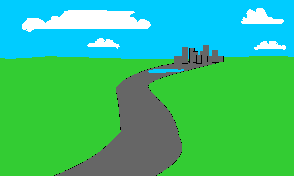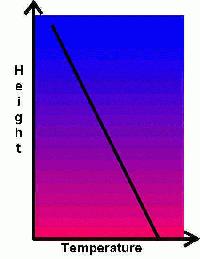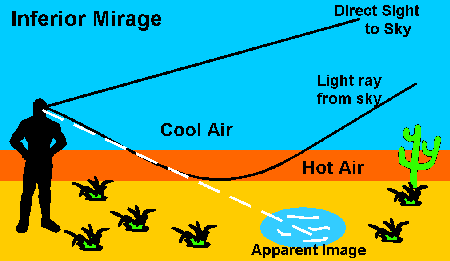 |
 |
| Home | Welcome | What's New | Site Map | Glossary | Weather Doctor Amazon Store | Book Store | Accolades | Email Us |
 | |||||||||||||||
The Inferior Mirage:
|
|||||||||||||||
 |
across roadway. |
Driving down the highway on a hot summer day, I look at the pavement ahead of me and see it covered with what appears to be a pool of water. But I never reach that wet pavement because rather than a pool of water, what I have observed was a mirage in a form commonly known as a highway mirage. Years ago, before highways spider-webbed the countryside and huge areas of land were paved or built upon, people would have called such a sight a desert mirage, or simply a mirage.
For many the word mirage brings thoughts of thirsty travelers moving slowly across desert sands toward the image of a pool of "cool, clear water" to quote a phrase from a popular country/western song. Whether our image is of cowboys in the US or Mexican desert, or of French Legionnaires lost in the Sahara Desert, we are likely to consider the mirage to be an illusion of an overstressed mind, a figment of the imagination of men and women parched with thirst. But while the mirage can create an optical illusion -- our eye seeing something and mind incorrectly interpreting the sight -- the mirage image is a real image and can be photographed. What our eye sees and mind initially interprets as water are actually light rays from the blue sky and clouds above and ahead of us refracted by strong changes in air density near the surface so that they appear to have come from the ground.
Mirages are now known to be more common sights than most people believed a century ago, perhaps because of increasing human alteration of the landscape which favours their formation. However, mirages have had significant impacts on beliefs of cultures around the world. Many legends, spiritual visions and folk tales can be seen to have their origins in the misinterpretations of the mirage phenomena.
The highway and desert mirages are examples of a mirage type known as the inferior mirage. The adjective inferior refers to the position of the perceived image -- below or inferior -- in relation to the actual position of the object. The other main form of mirage is the superior mirage in which the image is seen above the object. (For details on the superior mirage, see The Superior Mirage: Seeing Beyond in the Weather Elements and Phenomena Section.)
The inferior mirage forms when light rays passing through a relatively warm layer of air are bent upward from their path. But before we talk about the mirage itself, a brief physics lesson in optics. When light waves travel through one medium and into another, they are bent or refracted from their straight-line path to a degree that depends on the density difference between the two media. This can be simply demonstrated by placing a pencil in a glass of water and looking at it from the top or the side. The pencil appears to be bent or disjointed at the air/water boundary. Similarly refractions occur in the atmosphere when light passes through air layers of different densities.
 |
Temperature decreases with height. |
In the lower atmosphere the air density's greatest variations are caused by temperature changes, although changes in pressure and water vapour content also alter air density. Inferior mirages commonly form when the air near the ground is much warmer than that above it -- the relatively warmer the air, the greater the effect. (The superior mirage, on the other hand, forms when air is colder at the surface than the air above it.) Meteorologists call the changes of temperature with height the temperature gradient. When the temperature gradient is negative -- that is, temperature decreasing with height -- they call it a lapse rate or lapse condition.
I should point out here that the temperature difference between the altitudes/layers is a more important factor for inferior mirage formation than the absolute temperature. Highway mirages are as common over dry pavement on sunny winter days as during the summer months.
 |
As shown in the accompanying diagram, a layer of very warm air near the ground refracts the light from the sky nearly into a U-shaped bend (the actual shape of the curve is termed parabolic). What causes the mirage illusion is that our mind initially interprets the light rays reaching our eyes as having come along a straight path, which in this example must have originated on the ground. Thus, we see that patch of sky and cloud "on the ground" and interpret the image as a surface "pool of water." (Of course, as we see these mirages more often, our mind soon recognizes the image for what it is -- refracted skylight -- and the water illusion is gone.)
A rule of thumb for inferior mirage formation has been presented by Marcel Minneart in his classic book The Nature of Light and Colour in the Open Air from the temperature change between the air at the surface and that 1 metre (39 inches) above:
To give you some idea of how much hotter the air can be above a paved road in the full sun, measurements of temperatures 11 to 17 C deg (20 to 30 F deg) hotter at the surface than measured 1 cm (less than half an inch) above the surface have been recorded.
A patch of blue sky mixed with some cloud is the most common vision in an inferior mirage. But any object can be seen that is located at or beyond the mirage's apparent location. If you look closely, you can often see details such as vehicles in the highway mirage. Images are often inverted in the mirage, thus giving the appearance of the object being reflected in a pool of water.
When the temperature gradient is constant through the air layer that the light-ray paths have traversed from the object to the eye, the image will not be distorted. However, if the temperature gradient changes within the layer -- either continuously or divided into distinct layers -- the image can be distorted in any of a number of ways. The image may appear taller or stretched, a condition known as towering, or it may appear shorter or compressed, a condition called stooping.
Complex refractions through multiple density layers may cause both towering and stooping of different portions of a large object. The formation of multiple images is also possible to further create an unusual scene. When such complex conditions occur, you can often see different views of the object by altering your eye level, either up or down, thus catching different light ray paths.
One of the more interesting visions that may result from an inferior mirage is the illusion of someone walking on the water. Here is how this can happen. Under inferior mirage conditions, a flat surface stretching out ahead of the viewer can appear as if the viewer were standing atop an inverted bowl. This brings the optical horizon closer to the observer than the true geometric horizon of the Earth's curvature. With a little distortion added to the picture, it would thus be easy to mistake a person walking along the shoreline, or on a sandspit extending outward from the shore, of a hot sandy beach to appear to be walking on the water's surface.
Inferior mirages can be seen anywhere when a surface is hotter than the air above it. They can form over the hot metal of an automobile or truck, artificial turf, building roofs and even above ice and snow surfaces. The source of the heat need not be the sun either. A hot engine or barbeque can raise the temperature of its metal hood enough to form conditions for seeing an inferior mirage.
Inferior mirages may also form over heated vertical surfaces such as a rock face or wall, giving a surreal view of the surroundings appearing over this surface, including the "pool of water" illusion clinging to a vertical surface.
Next time you are out for a drive or a walk and see that "pool of water" in the distance, take some time to look more closely. You may see all kinds of detail in the mirage that you have never seen before.
For details on mirages, their causes and properties, see
The Mirage: A Primer in the Weather Elements and Phenomena Section,
The Superior Mirage: Seeing Beyond in the Weather Elements and Phenomena Section,
The Arctic Mirage: An Aid to Discovery in the Weather People and History Section.
and
Did Those Mountains Grow Overnight? in the Weather Almanac Section.
 |
To Purchase Notecard, |
Now Available! Order Today! | |
 |
 |
NEW! Now Available in the US! |
The BC Weather Book: |


